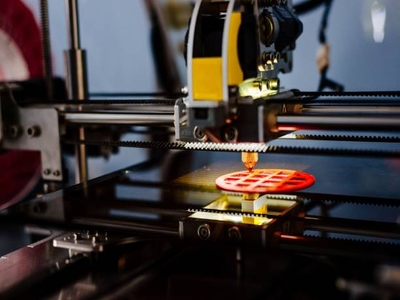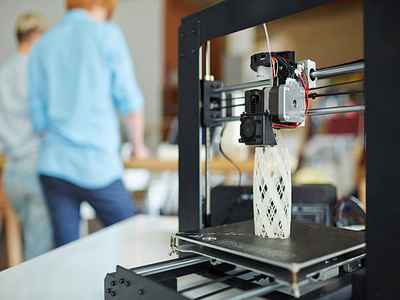There are many 3D printing technologies on the market, but which one should you choose for your project?
This article will compare PolyJet vs SLA printing methods to decide which is best for your needs. Keep reading to learn more!
PolyJet Vs SLA: What They Mean

Polyjet vs SLA: what is the difference between these two 3D printing technologies, and which one is suitable for your project?
While these printing methods share some similarities, they each have unique strengths and weaknesses.
First, let’s understand what they mean.
PolyJet Printers
PolyJet printers use inkjet technology to lay down layers of photopolymer resin on top of each other.
These layers are then cured with UV light and joined together, creating a smooth and detailed print.
PolyJet prints can be made in different colors or striated shades that give a realistic look.
This technique works well for smaller prints that need fine details and smooth surfaces, but it can struggle with larger prints because the layers are more visible at larger scales.
SLA Printers
SLA printers use an ultraviolet laser to harden photopolymer resin in a layer-by-layer process that results in high-resolution prints.
This method works incredibly well for complex or large objects, as very little post-processing is needed to achieve a smooth surface finish with minimal visible layer lines.
However, SLA prints often require support structures when making large or intricate pieces, resulting in additional post-processing time for removal.
Overall, PolyJet vs SLA depends mainly on your specific needs and application.
Read More: Cheap SLA 3D Printer. We review the most affordable options!
What is PolyJet Printing?
Prized for its ability to produce smooth, accurate parts with fine details and a wide variety of material properties, PolyJet is the best technology available for prototypes and many end-use parts.
However, as with all 3D printing technologies, there are some trade-offs to consider when choosing PolyJet.
For example, parts can take longer to print than with other technologies, and the costs per part are generally higher.
That being said, the advantages of PolyJet typically outweigh these disadvantages for applications that require high accuracy and many material properties.
Benefits
Some of the critical benefits of PolyJet printing include:
- Smooth surface finish and fine details.
- Ability to print in different colors or shades.
- Wide range of polymers are available with varying properties of the material.
Pros And Cons Of PolyJet Printing

PolyJet printing is additive manufacturing that has numerous benefits, including:
- On the one hand, this process allows for fast and precise prototyping of custom parts, making it ideal for designers and engineers.
- In addition, PolyJet can produce parts with a wide range of material properties simply by using different printing inks or resins.
- Furthermore, parts printed with PolyJet are strong, durable, and often more affordable than other manufacturing methods.
However, there are some downsides and drawbacks to PolyJet printing as well:
- Not all materials can be used in this process due to their high melting point or volatile chemical composition.
- Also, the complex design of most PolyJet printers means that they can be challenging to use and maintain.
- Finally, while individual parts printed with this method are typically robust and reliable, they may not hold up over time if put under too much strain or stress.
Despite these limitations, PolyJet printing is still a precious process for prototyping parts quickly and accurately.
What Is SLA Printing?
SLA printing, also known as stereolithography, is a 3D printing technology that uses a digital light projection system to solidify liquid materials into highly complex three-dimensional objects.
A Complex Process
The process begins with a photopolymer resin exposed to UV light to make it fully solid.
As the UV light passes through the other layers of existing solid material in the object being built, it cures the resin below and builds up the print structure in sequential layers.
This process allows for exact control over the shape and position of each layer, resulting in functionally complex 3D-printed creations with great details.
Maybe you want to experiment with SLA printing or use this advanced printing method for practical purposes.
Either way, understanding its unique properties and capabilities can help you get even more out of this innovative technology.
Benefits
There are many benefits to using SLA printing for your 3D printed projects, including:
- Superior surface finish and high precision.
- Ability to create complex, functional parts.
- A wide range of materials and printing inks are available.
Pros And Cons Of SLA Printing

SLA printing, also known as stereolithography, is an advanced form of 3D printing with advantages and disadvantages.
Some advantages include the following:
- On the one hand, SLA printing offers excellent precision and resolution, resulting in highly detailed printed models.
- Additionally, this technology creates fragile and delicate 3D structures, making it useful for applications like jewelry design or small intricate parts.
However, there are also a few drawbacks to SLA printing that need to be considered:
- For example, SLA printers can be pretty expensive, with high-end commercial models costing tens of thousands of dollars.
- In addition, while SLA printing is highly accurate and reliable when creating end products at a small scale, it may not always be as effective when producing larger objects.
Overall, whether or not SLA printing suits your needs depends on various factors, including budget and project requirements.
Nevertheless, this technology remains an essential tool in 3D printing and shows considerable promise for many different applications in the future.
Which To Choose?
If you are looking for a fast and reliable way to create highly detailed 3D printed parts, then SLA printing may be the right technology.
However, if you need to produce larger objects or work with a limited budget, PolyJet printing may be a better option.
The best 3D printing technology for your needs depends on a variety of factors, including the size and complexity of the objects you want to create, your budget, and the level of detail your projects require.
If you are still unsure which technology is right for you, consult a knowledgeable 3D printing service provider who can help you choose the best solution.
You can start by listening to expert Xometry Greg in the video below:
Final Words
So, which 3D printing technology should you choose for your needs when comparing PolyJet vs SLA?
If you need a high level of detail and a fine surface finish, SLA is better.
However, PolyJet offers more material choices and can produce parts faster.
Ultimately, it’s up to you to decide which technology will work best for your specific application.
Articles You Might Enjoy Reading: